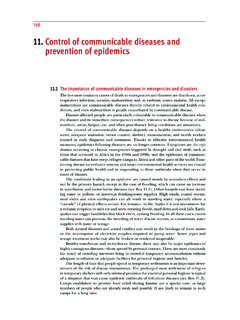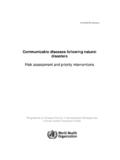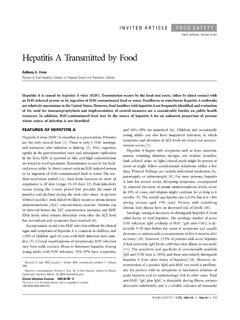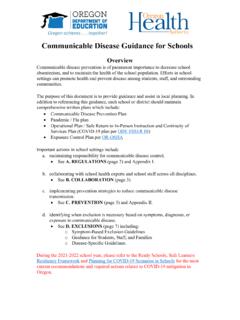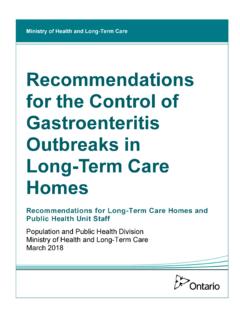Transcription of Prevention & Control of WATER BORNE DISEASES
1 Prevention & Control of WATER BORNE DISEASES AAccttiioonn PPllaann--22001177 HHEEAALLTTHH DDEEPPAARRTTMMEENNTT NNEEWW DDEELLHHII MMUUNNIICCIIPPAALL CCOOUUNNCCIILL 2 AACCTTIIOONN PPLLAANN AANNDD SSTTAATTUUSS RREEPPOORRTT 22001177 3 CONTENTS Pages 1. Introduction of WATER BORNE DISEASES 4 12 2. Action Plan 13 27 3. Method of Implementation of Action Plan 28 32 4. Status Report of WATER BORNE DISEASES 33 40 5. Performas for Epidemiological Investigation 41 49 4 INTRODUCTION Infectious DISEASES spread from infected person to another person through various routes.
2 WATER BORNE DISEASES spread through WATER contaminated with human or animal faeces (including food and utensils, which have been washed with the contaminated WATER and dirty hands). These DISEASES are also known as faeco-orally transmitted DISEASES . There are other DISEASES , which could be WATER related but not transmitted by the faeco-oral route malaria, leptospirosis etc. WATER gets contaminated under poor hygienic and in-sanitary conditions. Contamination can occur at the source of WATER supply, while passing through WATER pipes, which are broken, or in the homes when WATER is not stored properly.
3 The number of people affected will depend on the place of contamination. The risk of WATER - BORNE DISEASES is higher in areas with: Inadequate WATER supply Poor quality of WATER and sewage pipelines Poor sanitary conditions Step wells and uncovered wells used as sources of drinking WATER Defecation in the open especially near sources of drinking WATER Poor system for the disposal of human waste The WATER - BORNE DISEASES can also occur if contaminated WATER is used for washing utensils, fruits and vegetables, especially if these are eaten raw. WATER BORNE DISEASES can be transmitted through ice prepared with WATER from unreliable sources.
4 COMMON SOURCES OF INFECTION Drinking WATER Contaminated at its source. Contaminated during supply & storage. Ice made from contaminated WATER . Food Contaminated during or after preparation. Fruits and vegetables, washed with contaminated WATER and eaten raw. Fruits and vegetables, grown at or near ground level and fertilized with night soil or irrigated with WATER contaminated with human waste, and eaten raw. 5 While cases of WATER BORNE DISEASES may occur throughout the year, a seasonal increase is noted in the summer, monsoon and post-monsoon period.
5 The risk of large outbreaks of WATER - BORNE and WATER related DISEASES increases following heavy rains. 1. WATER BORNE DISEASES OF PUBLIC HEALTH IMPORTANCE WATER BORNE DISEASES are considered to be of public health importance for the following reasons: Potential for causing large outbreaks. High disease burden due to the large number of cases and deaths, especially in young children. In many states and districts, WATER BORNE DISEASES are major causes of pediatric indoor admissions and outpatient visits to the hospitals and health facilities. No specific treatment is available for some viral DISEASES such as hepatitis E.
6 Increasing anti-microbial drug resistance is being recorded for some bacterial DISEASES . Potential for causing panic in the community and negative media coverage. 6 WATER BORNE DISEASES OF PUBLIC HEALTH IMPORTANCE 1. THOSE CAUSED BY THE PRESENCE OF AN INFECTIVE AGENT (a) Viral : Viral hepatitis A Hepatitis E Poliomyelitis Rotavirus diarrhea in infants (b) Bacterial : Typhoid fever Paratyphoid fever Bacillary dysentery, E. Coli. Diarrhea Cholera (c) Protozoal : Amoebiasis, Giardiasis (d) Helminthic : Roundworm Threadworm Hydatid disease . (e) Leptospiral : Weil s disease 2.
7 THOSE CAUSED BY THE PRESENCE OF AN AQUATIC HOST (a) Snail : Schistosomiasis (b) Cyclops : Guineaworm Fish tape worm 7 1. ACUTE DIARRHOEAL DISEASES IN YOUNG CHILDREN Diarrhoea is the passage of loose or watery stools more than three times a day. However, it is the recent change in the consistency and character of stools that is more important than the number. Passage of frequent formed stools, passage of pasty stools in a breast-fed in fact during or immediately after feeding should not be considered as diarrhoea. Diarrhoea is classified by clinical syndromes as acute watery diarrhoea (majority of the cases), dysentery (blood in the stools) and persistent diarrhoea.
8 Such classification is important for the management of cases. Although cholera is a form of acute watery diarrhoea, it is discussed separately. CLASSIFICATION OF DIARRHOEA (by clinical syndrome) Acute watery diarrhoea Dysentery (blood in the stools) Persistent diarrhoea Acute diarrhoea starts suddenly and is characterized by the passage of loose watery motions. Patients of diarrhoea recover within three to seven days. If diarrhoea persists for more than 14 days and is associated with weight loss it is classified as persistent diarrhoea. Persistent diarrhoea, which is recurrent or long lasting, due to non-infectious causes such as sensitivity to gluten or inherited metabolic disorders.
9 More than three-fourths of all diarrhoeal episodes are acute watery diarrhoea. Diarrhoeal DISEASES are common in children under five years of age and are among the major causes of deaths in children in this age group. It is presumed that one in four (or five) deaths in children under five years of age are due to diarrhoea. In districts where appropriate case management of diarrhoea is not widely practices, up to a third of pediatric hospital admissions and 20% of the deaths of inpatients are diarrhoea related. Estimates based on the current child mortality rates indicate that more than 6,00,000 children die annually due to these DISEASES in India.
10 2. CHOLERA Cholera is a form of acute watery diarrhoea. More than 90% of sporadic cases in endemic areas are mild and difficult to distinguish clinically from other types of acute diarrhoea. In epidemic situations, however, there is rapid onset of severe watery diarrhoea and vomiting, resulting in loss of large amounts of fluids and electrolytes from the body. The condition of the patient can deteriorate rapidly in the absence of medical care. If treatment is delayed or inadequate, death may occur rapidly from dehydration and circulatory collapse. Cholera should be suspected if patients older than 5 years of age develop severe dehydration from acute watery diarrhoea (usually accompanied with vomiting).
